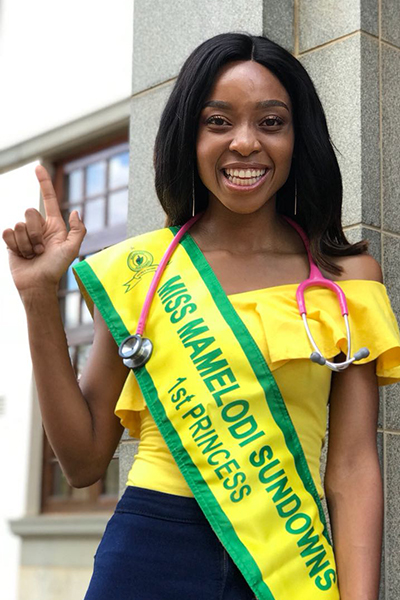Latest News Archive
Please select Category, Year, and then Month to display items
16 February 2018
Photo Supplied
 Thato Mosehle was recently crowned Miss Mamelodi Sundowns First Princess
Thato Mosehle was recently crowned Miss Mamelodi Sundowns First Princess
“True beauty is how you make a person feel, and I believe that I’m very beautiful,” said Thato Mosehle; Miss Mamelodi Sundowns First Princess and UFS medical student.
When asked what she thought her edge was over the other contestants in the competition, Thato replied: “I will not speak about them. I will speak about myself and say it was the fact that I was true to who I am.” It is clear that Thato’s zealous character and clear sense of identity are among the determinants of her victory.
Thato explained that her journey began when she could no longer play for the provincial netball team due to an injury she incurred on the court. She was very disappointed because she was relying on her netball skills to help her obtain a bursary to fund her studies. Despite this adversity, Thato was determined to be active and do something significant and profitable with her time. She began entering beauty pageants in and around Bloemfontein, such as Miss Glamorous 2016, Miss Armentum 2017, and Miss Environment.
“True beauty is
the ability to
give someone a
sense of warmth
when you arrive.”
—Thato Mosehle
Miss Mamelodi Sundowns
First Princess.
She said her prime motivation for entering this particular pageant was the prize money she could win that would help fund her studies. She described how the UFS facilitated her triumph through the challenging analysis methods from which her studies and overall knowledge and confidence derived. Thato explained that she respected the Miss Mamelodi Sundowns pageant as it promoted the empowerment of women.
As a final-year medical student and Mamelodi Sundowns brand ambassador, Thato is smart enough to understand that with a specific title comes a definitive responsibility that you owe to yourself to fulfil. She explained that the essence of her win was that in the Free State, she was not just the 1st princess, she was the queen. Thato added that if students had a vision they should plan effectively and go for it.
Photo manipulation in journalism: evil, crutch or lifebuoy?
2017-09-04

Albe Grobbelaar, veteran journalist and lecturer in the
Department of Communication Science at the UFS.
Photo: Rulanzen Martin
Since the 1800s the manipulation of photographs has been common practice, and who can forget the OJ Simpson Time magazine cover in 1994? Albe Grobbelaar, lecturer in the Department of Communication Science at the University of the Free State (UFS), asked in a special lecture on 18 August 2017 whether “Photo manipulation in Journalism” was an evil habit, a crutch or a lifebuoy.
“As a journalist I have always been interested in photography. And the principle of photo manipulation or tampering with photos, as we call it, is something that has interested me ever since,” Grobbelaar said. Photo manipulation is an area that has garnered many academic interest and is not a new trend but a practice that started in the 1830s when photos came into popular use. “It is not always done with ulterior motives, artists played with photographs to get unique effects.” Photo manipulation is not only to create fake news, but is sometimes used to convey novelty and create shock to news readers.
Different viewpoints for different circumstances
He talked about the spectrum of viewpoints on photo manipulation. Some conservative journalism schools say photos should never be retouched while other feel it is fine to tamper with pictures. “What I tried to convey in the lecture was that one should consider different circumstances differently,” Grobbelaar said. As a journalist he believes that news photos should never be manipulated.
He mentioned the example of the mugshot of OJ Simpson that the Los Angeles Police Department released to the media. “Newsweek and Time both used the photo on their front pages, but Time deliberately darkened the picture so that OJ, a black man, would appear more sinister,” Grobbelaar said. It is, however, common practice in the fashion industry to retouch images that are used in fashion magazines.
Use own judgment to validate photos
In the age of social media it has become easy to manipulate photos and which has been labelled fake news. “I would advise people to use their own judgment when validating the authenticity of photos,” Grobbelaar said. It is important to verify whether they are from a reliable news outlet.